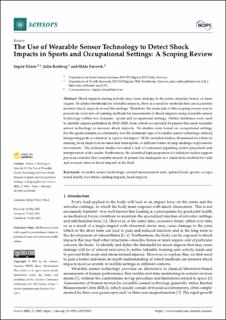| dc.contributor.author | Eitzen, Ingrid | |
| dc.contributor.author | Renberg, Julie | |
| dc.contributor.author | Færevik, Hilde | |
| dc.date.accessioned | 2022-05-06T11:07:15Z | |
| dc.date.available | 2022-05-06T11:07:15Z | |
| dc.date.created | 2021-09-29T17:19:33Z | |
| dc.date.issued | 2021 | |
| dc.identifier.citation | Sensors. 2021, 21, (15), 4962. | en_US |
| dc.identifier.issn | 1424-8220 | |
| dc.identifier.uri | https://hdl.handle.net/11250/2994541 | |
| dc.description.abstract | Shock impacts during activity may cause damage to the joints, muscles, bones, or inner organs. To define thresholds for tolerable impacts, there is a need for methods that can accurately monitor shock impacts in real-life settings. Therefore, the main aim of this scoping review was to present an overview of existing methods for assessments of shock impacts using wearable sensor technology within two domains: sports and occupational settings. Online databases were used to identify papers published in 2010–2020, from which we selected 34 papers that used wearable sensor technology to measure shock impacts. No studies were found on occupational settings. For the sports domain, accelerometry was the dominant type of wearable sensor technology utilized, interpreting peak acceleration as a proxy for impact. Of the included studies, 28 assessed foot strike in running, head impacts in invasion and team sports, or different forms of jump landings or plyometric movements. The included studies revealed a lack of consensus regarding sensor placement and interpretation of the results. Furthermore, the identified high proportion of validation studies support previous concerns that wearable sensors at present are inadequate as a stand-alone method for valid and accurate data on shock impacts in the field. | en_US |
| dc.language.iso | eng | en_US |
| dc.publisher | MDPI | en_US |
| dc.rights | Navngivelse 4.0 Internasjonal | * |
| dc.rights.uri | http://creativecommons.org/licenses/by/4.0/deed.no | * |
| dc.subject | Wearable sensor technology | en_US |
| dc.subject | Inertial measurement unit | en_US |
| dc.subject | Optimal load | en_US |
| dc.subject | Sports | en_US |
| dc.subject | Occupational health | en_US |
| dc.subject | Foot strike | en_US |
| dc.subject | Landing impacts | en_US |
| dc.subject | Head impacts | en_US |
| dc.title | The Use of Wearable Sensor Technology to Detect Shock Impacts in Sports and Occupational Settings: A Scoping Review | en_US |
| dc.type | Peer reviewed | en_US |
| dc.type | Journal article | en_US |
| dc.description.version | publishedVersion | en_US |
| dc.rights.holder | © 2021 by the authors. Licensee MDPI, Basel, Switzerland. This article is an open access article distributed under the terms and conditions of the Creative Commons Attribution (CC BY) license (https:// creativecommons.org/licenses/by/ 4.0/). | en_US |
| dc.source.pagenumber | 29 | en_US |
| dc.source.volume | 21 | en_US |
| dc.source.journal | Sensors | en_US |
| dc.source.issue | 15 | en_US |
| dc.identifier.doi | 10.3390/s21154962 | |
| dc.identifier.cristin | 1940829 | |
| dc.relation.project | Norges forskningsråd: 194068 | en_US |
| cristin.ispublished | true | |
| cristin.fulltext | original | |
| cristin.qualitycode | 1 | |

